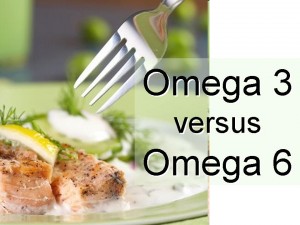SNI: Folks talk constantly about having the proper ratio between omega-6 and omega-3 fatty acids. What is the ‘ideal’ ratio (if it exists) and why?
Dr. Bibus: This is a common but very good question. With the excessive consumption of omega 6 largely as soybean oil in the standard American diet, current dietary ratios of omega 6 to omega 3 are from 10 to 20:1. Large amounts of omega 6 in the face of smaller amounts of omega 3, reduce our bodies own metabolism omega 3, facilitating omega 3 deficiency. See attached figure from Holman circa 1964 (Slide #3 in PPT). Ideally if we can reduce our dietary ratio to 1:1 by limiting intake of omega 6 and/or increasing omega 3 we can get significant conversion of omega 3. I typically state the ‘ideal’ dietary omega 6 to omega 3 ratio to be less than 5 to 1. Below a 5 to 1 ratio we begin to see decent conversion of omega 3 and our blood levels of omega 3 increase to more healthy levels. Dr Bill Lands has made food selection simple for determining your omega 3 balance. You can find his Omega 3-6 Balance Score program at www.FastLearner.org.
SNI: Of the omega 3 fats, what are the similarities and differences vis a vis their benefits between EPA and DHA? Also, what’s the scoop on DPA?
Dr. Bibus: All long chain omega 3 like EPA, DPA and DHA have anti-inflammatory characteristics. EPA however tends to be touted more as the anti-inflammatory omega 3 as it is converted into series 3 eicosanoids or hormone like compounds that have much lower inflammatory potentials than those derived from omega 6. DHA is typically found in membranes or the bags that surround our cells. DHA is thought to be a major player in how our cells communicate through membrane interactions of expression of genes or our DNA. DHA is also important for glucose uptake in muscle as insulin sentivity of muscle is predicted by muscle content of DHA. Our eyes, brain and liver have fairly high levels of DHA. DHA makes up the majority of the fatty acids in he retina and about 20% in brain. DPA is the exciting ‘new’ omega 3 fatty acid. DPA has always been ‘around’ but research is increasingly recognizing its significance. It is structural similar to DHA with just 1 less double bond. We tend to store twice the amount of DPA in our blood than EPA and about half as much DPA as DHA. While DPA is found only in small amounts in our diet, unless you are eating Menhaden or taking sources of menhaden oil, its significant presence in the blood comments on it potential for health. Several studies have reported blood levels of DPA to be as predictive or more predictive of cardiovascular risk than EPA and DHA yet this nutrient is often ignored when we talk about omega 3. DPA is in fact often referred to as “other” omega 3 on supplement labels. There is an increasing awareness around DPA and its health benefits so look for new products touting DPA in your nutrition stores soon.
SNI: I have an acquaintance who takes 10 grams of fish oil daily. Can you take ‘too much?’ And if so, what are the side effects? What is the ‘ideal’ dose of fish oil per day?
Dr. Bibus: I often take 10 grams per day which represents about 10% of my normal daily fat intake. Can you take too much…from a practical standpoint no. Arctic populations living on marine based diets consume on average 100-200 grams of marine based fat per day from fish, seal and whale blubber. These populations have very low levels of heart disease but do have a tendency to bleed longer. Bleeding is NOT a problem for people taking fish oil supplements. The FDA conservatively states that up to 3g or 3000mg of EPA and DHA are safe to consume each day. For standard fish oil this is about 10grams per day. There are no real side effects to fish oil consumption. If you are taking medications to prevent clotting or have a clotting disorder you should talk to your physician about fish oil before you start taking it. There is no federal recommendation for how much long chain omega 3 (EPA, DPA and DHA) should be in our daily diet. I advocate consuming 2000mg or 2g of EPA, DPA and DHA combined per day. This is about 7 – 1gram capsules of standard fish oil or 2-3 grams of concentrated fish oil. Why 2000mg? This is the amount required to raise our blood values of omega 3 to around 50% omega 3 in HUFA (highly unsaturated fatty acids) which is correlated with a 50% reduction in the incidence of death.
SNI: Many middle-aged men take both aspirin and fish oil. Inasmuch as both increase clotting time, should these two be taken concurrently?
Dr. Bibus: Taking aspirin and fish oil both reduce clotting time which is a GOOD thing. In America, our high omega 6 diet causes us to clot too much. Salicylates or aspirin has many health benefits outside of reducing clotting. Regular aspirin consumption has been also reported to reduce cancer risk. If you have a clotting disorder you should consult with your doctor before starting any fish oil regimen.
SNI: Why do some fish oil products taste so ‘fishy’ and smell like a wharf in San Francisco while others seem to be less stinky?
Dr. Bibus: The fishy smell from fish comes from certain nitrogen containing compounds (tertiary amines) and also from oxidized omega 3. There are many different types of oxidized fatty acids often called aldehydes. One type in particular can be smelled by our nose at relative small concentrations, helping our noses determine good from bad fish oils. That fishy smell comes from break down or degradation products of fish oil. Good clean fish oil will have a very slight to no fishy aroma. Fish oil processing helps clean up fish oil and proper storage and handling if fish oil, once made, are critical for keeping an oil healthy and oxidtaively stable. A general rule of thumb is that if an oil smells bad it is bad and should be avoided. Oxidized fatty acids are not healthy for u to consume. Happily most oil producers today do a good job at produce stable oils. There are still a few bad actors but luckily your nose can show you the way!
SNI: What new projects do you have on the horizon? Tell the SNI audience please.
Dr. Bibus: I am really excited to see a number of new products focused on athletic performance in the omega 3 area. Also a number of DPA enriched omega 3 products will soon be entering the market place. A company called Omega Protein has learned how to enrich DPA and are now selling omega 3 oils with up to 10% DPA. There are also a host of omega 3 delivery systems that are out there now. Emulsions are particularly interesting to me as they offer omega 3 in a form that is readily absorbed. A number of fish oils are now concentrated which helps reduce the overall pill count to achieve 2-3 g per day intakes of long chain omega 3.
About Dr. Bibus – Dr. Doug Bibus received his BS from Mankato State University and earned his MS in nutrition and Ph.D in nutritional biochemistry from the University of Minnesota. Dr. Bibus is a community faculty member at the University of Minnesota’s Center for Spirituality and Healing and a researcher in the area of fatty acid biochemistry and nutrition. Dr. Bibus is considered as one of the top omega 3 experts in the world, a distinction that stems from his work at the academic lab (Professor Ralph T. Holman) that invented the omega 3 terminology as well as discovered the metabolism and definitive essentiality of omega 3. Dr Bibus’s research interests include the role of essential fatty acids in human and animal nutrition, the role of omega 3 fatty acids in attenuating the inflammatory response, the application of fatty acids in the treatment of disease and the impact of oxidative stress on performance animals and humans. Dr. Bibus is a member of The American Oil Chemists’ Society, The American Chemical Society, The Society for Critical Care Medicine and The International Society for the Study of Fatty Acids and Lipids. He has been a two-time winner of the American Chemical Society’s Award in Analytical Chemistry. Dr. Bibus is a foundation board member for AOCS and chairman of the health and nutrition division and award committee.


